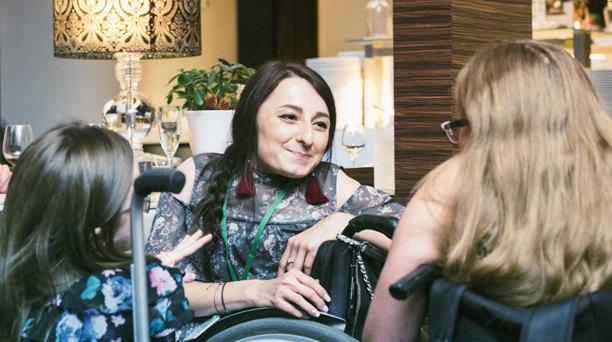OI (commonly known as brittle bone disease) is a serious, rare genetic disorder caused by a problem in the formation of type I collagen, and characterized by fragile bones that fracture easily, often starting from birth. It can affect people’s lives in a multitude of ways, from frequent fractures and skeletal deformities to constant chronic pain, respiratory insufficiency and hearing loss. And each person’s experience is different.
Ingunn Westerheim, President of OIFE, shares her experiences of life with Osteogenesis Imperfecta in an April 2020 interview.
How is OI treated?
There are currently no FDA- or EU-approved treatments for OI. Current treatment is based on supportive care, using off-label, unapproved compounds to seek to improve bone density, on treating fractures as they occur (a common occurrence particularly in children with OI) and on maximizing mobility via physiotherapy, pain management and orthopaedic surgery.
The majority of cases of OI (up to 90%) are caused by a dominant mutation in the genes coding for Type I collagen – a key component of healthy bone. As setrusumab (UX-143) aims to act on pathways regulating both bone formation and bone resorption (breakdown and assimilation of old bone), our clinical studies are seeking to understand if setrusumab can play a role in improving the health and quality of life for people with OI.
OI is recognized as an area of high unmet medical need. Setrusumab has been designated an ‘Orphan Drug’ in the USA and the EU, meaning it is officially acknowledged by the regulatory authorities to be targeting a rare and serious disease.
In October 2024, setrusumab received Breakthrough Therapy Designation from the FDA. The FDA’s decision is based on preliminary clinical evidence including the positive 14-month results from the Phase 2 portion of the Orbit study, which demonstrated a rapid and clinically meaningful decrease in fracture rate in patients (ages 5-<26) receiving setrusumab compared to pre-treatment fracture rates and from the completed Phase 2b ASTEROID study in adult patients. Breakthrough Therapy Designation aims to expedite the development and review of drugs that are intended to treat serious or life-threatening diseases and whose preliminary clinical evidence indicates that the drug may demonstrate substantial improvement on one or more clinically significant endpoints over existing therapies.
Setrusumab has been granted Rare Pediatric Disease Designation by the FDA in recognition of the significant unmet medical need in children. In Europe, setrusumab has been granted PRIority MEdicines (PRIME) designation by the European Medicines Agency (EMA), and has been accepted in the EMA’s Adaptive Pathways programme. The PRIME programme is aimed at supporting the development of medicines that target an unmet medical need.
Clinical Status
Ultragenyx and Mereo BioPharma are collaborating on the development of setrusumab globally, based on a joint collaboration and license agreement. Together, we have developed a comprehensive late-stage program to continue development of setrusumab in pediatric and young adult patients across OI sub-types I, III and IV.
The two Phase 3 clinical trial programs, led by Ultragenyx, completed enrollment in April 2024.
In patients aged 5 to 25 years, the global, seamless Phase 2/3 Orbit study was designed to evaluate the effect of setrusumab compared to placebo on the rate of annualized clinical fracture, the study’s primary endpoint.
The Phase 2 portion of the Orbit study enrolled 24 patients and was randomized 1:1 to test two doses of setrusumab, 20 and 40 mg/kg. Both doses were shown to rapidly increase levels of the bone formation biomarker, P1NP. In data reported in June 2024, the large reduction in annualized radiologically confirmed fracture rate previously reported in patients treated for a minimum of 6 months was sustained in patients treated for at least 14 months with a high degree of statistical significance. The median annualized rate of radiologically confirmed fractures across all 24 patients in the 2 years prior to treatment was 0.72. Following a mean treatment duration period of 16 months, the median annualized fracture rate was reduced to 0.00 (p=0.0014; n=24), reflecting a 67% reduction relative to the pre-treatment period.
“All indications are that setrusumab is having the effect we hoped for, safely reducing the incidence of fractures and improving BMD in patients with OI,” said Gary S. Gottesman, M.D., Professor of Pediatrics and Medicine, Washington University School of Medicine. “The anti-sclerostin antibody appears effective even after a year and remarkably, patients continue to make measurable gains, suggesting we will see an ongoing response over the long term.”
Since there was no statistical difference between the 20 and 40 mg/kg doses in Phase 2, 20 mg/kg was selected as the Phase 3 dose. The Phase 3 part of the study has enrolled 158 patients, with a 2:1 randomization to receive setrusumab or placebo with a primary endpoint of the rate of annualized clinical fractures. Interim analyses of the Phase 3 data are planned around the end of 2024 and several months later. If needed, the final analysis is planned at 18 months. After achieving the study's primary endpoint, all patients will transition to an extension period and receive open-label setrusumab.
In patients aged 2 to <7 years, the open-label, randomized, active-controlled Phase 3 Cosmic study is evaluating setrusumab compared to intravenous bisphosphonate (IV-BP) therapy on annualized total fracture rate. Cosmic completed full enrollment with 69 patients and analysis of the data will be aligned closely with the analysis of the Orbit study.
The potential of setrusumab in adults with OI, was highlighted in Mereo BioPharma’s Phase 2b study (ASTEROID) treatment phase of the dose-finding study. This study recruited 112 adults and was concluded in 2019. ASTEROID demonstrated treatment with setrusumab resulted in a clear, dose-dependent and statistically significant effect on bone formation and bone density at multiple anatomical sites among adult participants with OI.
Mereo retains rights to commercialization in Europe/EEA and UK.




